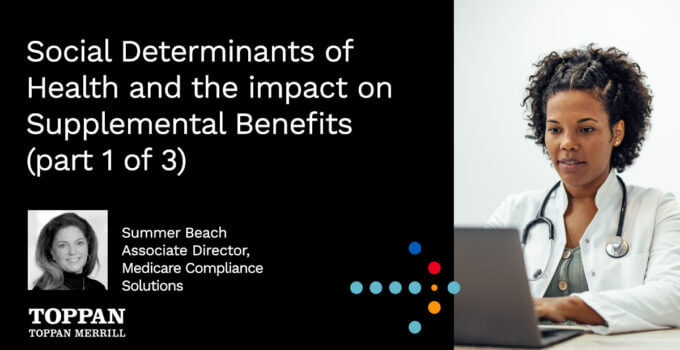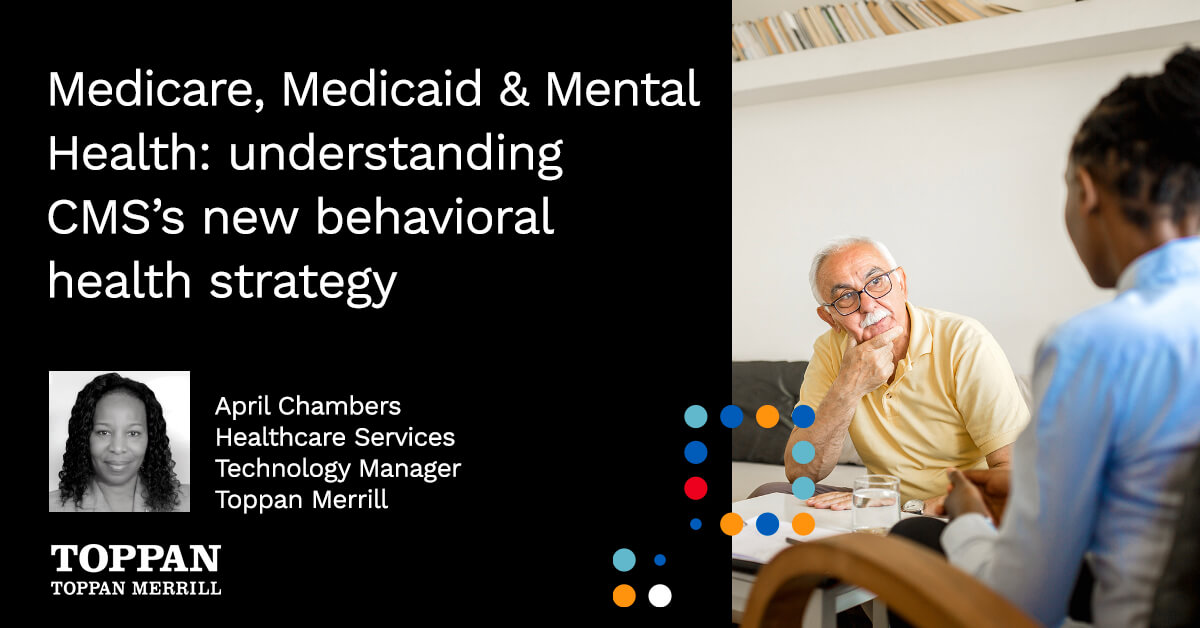To explore these trends, we are introducing a three-part blog series that explains how SDOH impacts supplemental benefits. This article will provide a foundation for our discussion, explaining basic concepts and detailing a little history.
What are Social Determinants of Health?

According to the U.S. Office of Disease Prevention and Health Promotion, “Social determinants of health are the conditions in the environments where people are born, live, learn, work, play, worship, and age that affect a wide range of health, functioning, and quality-of-life outcomes and risks.”
SDOH may not be medical in nature, but they can impact health in a variety of ways. One example is that individuals without easy access to grocery stores (or the money to afford healthier foods) may not eat as nutritiously as others with access. In turn, poor nutrition can lead to health conditions such as diabetes or obesity and ultimately lower the odds that those affected will lead a long or healthy life.
In fact, the University of Wisconsin Population Health Institute found that 40% of health outcomes were directly impacted by social and economic factors, while health behaviors (e.g., tobacco use, exercise) make up 30% and clinical care accounts for just 20%.
Understanding Social Determinants of Health
Social Determinants of Health can generally be grouped into five categories:

Overall, there is an increasing understanding that SDOH could influence health outcomes as much or more than clinical care. SDOH are very complex. The problems they underline have causes that are far outside the scope of traditional health coverage, but many organizations are working to address these disparities as a central focus of new supplemental programs.
This trend includes many Medicare Advantage plans. However, the manner in which SDOH are addressed can vary. A study conducted by the JAMA Network, surveyed 38 participants from 17 MA plans and identified three important themes.
- Survey respondents see value in addressing SDOH
- However, participants have different opinions on whether MA plans should directly address SDOH or focus that support on third-party entities that provide those services
- The decision to provide SDOH is complex, relying on a need for evidence of efficacy, return on investment, and community partnerships as well as input from the U.S. Centers for Medicare & Medicaid Services
What are Supplemental Benefits?
One of the ways that Medicare Advantage plans are meeting the needs implied by SDOH is through supplemental benefits. The Better Medicare Alliance offers this definition of supplemental benefits as they relate to SDOH: “Plans can now cover adult day care services, in-home support services, non-opioid pain management, food insecurity, home safety modifications, and transportation, allowing plans to offer benefits that directly address SDOH.”
Some Medicare Advantage programs may provide a variety of innovations that help address examples of SDOH shown below:
- Home Safety: SilverSneakers — This is a community-based fitness program and popular in many Medicare Advantage plans. It helps older adults improve and maintain their ability to balance and preserve their physical mobility to reduce the risk of related accidents in participant homes.
- Food Security: This provides plan members with weekly meal deliveries. Since inception, some plans have seen the number of emergency room visits by plan participants decrease significantly.
- Transportation: When offered, this benefit helps Medicare Advantage plan participants to keep their medical appointments through courtesy door-to-door transportation services. Depending on the benefit structure, the service is offered as one-way, or round-trip transportation with a maximum number of ‘trips’ per calendar year.
- Family and Social Support: Isolation is identified in many demographics as a social determinant of health and is associated with mental health diagnoses such as depression and anxiety. Services providing family and social support, help remedy loneliness in members by providing free medical transportation as well as weekly phone calls and wellness programs.
Meeting the needs of specific demographics
In an August 2021 report, the Better Medicare Alliance announced that the number of Medicare Advantage plans that are offering supplemental benefits to address SDOH tripled in just one year, moving to 845 plans in 2021 from just 245 in 2020.
“As Medicare Advantage enrollment continues to soar — driven by diverse, medically complex, and at-risk beneficiaries — it is crucial that it be equipped with the tools to deliver whole-person care to this increasingly vulnerable population,” explains Kenneth Thorpe, the chair of the Better Medicare Alliance’s board of directors. “This report paints an encouraging picture of the significant investments Medicare Advantage plans and partners are already making in this space, with the number of Medicare Advantage plans providing SSBCI increasing more than three-fold in a single year. Sensible policy changes can spur further innovation. From clear, consistent standards on SDOH data collection to putting Value-Based Insurance Design to work for beneficiaries and modernizing risk adjustment and Star Ratings to reflect the reality of SDOH’s impact on health outcomes, this report offers a vision for a future where social needs are seen, met, and fully integrated into the health care experience.”
Anecdotally, Toppan Merrill has seen an even higher rate of adoption. According to Jen Trewick, Principal Product Manager, “All but two Medicare Advantage plans we service have some form of supplemental benefit, which is a big change from previous years.”
However, there are challenges to the introduction and adoption of supplemental benefits to impact SDOH. “The health care system recognizes the significant impact of unmet social needs on peoples’ health and wellbeing,” says Caroline Pearson, Senior Vice President of the National Opinion Research Center, the nonpartisan and objective research organization NORC at the University of Chicago. “However, we lack a systematic approach for identifying social needs, paying for interventions to address those needs, and evaluating the outcomes of these programs. With policy support, Medicare Advantage plans can play a crucial role in addressing these social determinants of health.”
The future of Supplemental Benefits and SDOH
Moving forward, the future of SDOH-driven supplemental benefits is unclear. The Center for Medicare and Medicaid Innovation (CMMI) warns that voluntary models, like those with supplemental benefits, can have major disadvantages. CMMI Director Liz Fowler explains, “What we have learned from CMMI models over the past 10 years is that voluntary models [are] subject to risk selection, which has a negative impact on the ability to generate system-level savings.” She added that providers who do not generate revenue using those models tend to exit the program, which causes a problem for CMMI, which has traditionally evaluated whether a model is successful based on its total impact on costs. As such, CMMI is exploring more mandatory models. “I realize those come with their own set of disadvantages,” said Fowler.
As the CMMI looks at voluntary vs. mandatory models, supplemental benefits are gaining steam outside of Medicare Advantage. In the next article from our “How Social Determinants of Health Impact Supplemental Benefits” blog series, we explore what supplemental benefits and SDOH look like in practice.
How Toppan Merrill can help
Toppan Merrill is the best-in-class partner for complex, secure communications that delivers premier technology driven solutions to more efficiently and accurately communicate mission critical content. Built on the needs of today’s clients and the requirements of tomorrow’s, we deliver a proactive partnership rooted in deep market expertise, flexible solutions built around your business needs, and a commitment to forward-thinking technology that ensures speed, precision and accuracy.
With expertise in health plan regulated communications, Toppan Merrill delivers unmatched service around the world.
Learn more about our Health Plans Regulated Communications solutions at www.toppanmerrill.com.



